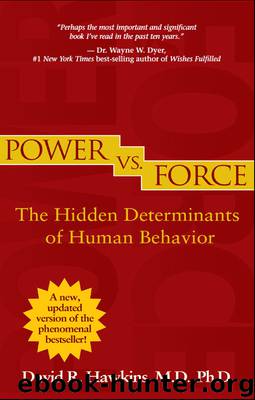Power vs. Force by David R. Hawkins M.D. Ph.D

Author:David R. Hawkins, M.D., Ph.D.
Language: eng
Format: epub
Publisher: Hay House, Inc.
Published: 2012-04-03T16:00:00+00:00
We’ve made calibrations of various kinds of records of athletic achievement, including movies. Of all the movies about sport studied, the French film The Big Blue produced the highest calibration.1 This is the story of Jacques Mayol, the Frenchman who held the world record for deep-sea diving for many years (until very recently). The movie calibrates at the extraordinary energy level of 700 (universal truth), and has the capacity to put viewers into a high state of consciousness—the manager of one movie theater that showed it described audiences wandering out lost in silence or crying with a joy they couldn’t describe.
Through the use of slow-motion photography, the movie achieves an accurate depiction of the world’s greatest deep-sea diver in elevated states of consciousness. A subjective sensation of slow-motion, beauty, and grace is frequently noted in higher states; time seems to stop, and there’s an inner silence, despite the noise of the world.
We see throughout the film that Jacques Mayol maintains this state by the intensity of his concentration, which keeps him in an almost constant meditative condition. In this mode, he transcends ordinary human limitations, for he becomes enabled to achieve great feats through altered physiology. The deeper he dives, the slower his heartbeat becomes, and his blood distribution concentrates almost entirely in his brain. (This also happens in porpoises.) His best friend, himself a highly evolved athlete, dies in an attempt to match Mayol’s feat because he hadn’t reached the level of consciousness required to transcend the normal limits of the body.
The subjective experience of effortless bliss also occurs in other types of exceptional physical performance, such as that of the world-famous Sufi dancers known as whirling dervishes, who, through discipline and exhausting practice, become able to move effortlessly through space over long periods of time with dazzling precision.
The most highly developed martial arts clearly demonstrate how motive and principle are of ultimate importance in extraordinary athletic achievement.2 The most frequently heard admonition to trainees is: “Stop trying to use force.”3 Schools devoted to these arts produce masters whose overriding concern is victory of the higher self over the lower through control, training, and commitment to goals aligned with true power.4 Alignment with these high-power attractor patterns isn’t limited to the exercise of the discipline itself but becomes an entire lifestyle. Thus, when the power of the principle is transferred to the practitioner, the results begin to be manifested everywhere in his life.
The hallmark of true greatness in athletic achievement is always humility (such as that exhibited by Pablo Morales after winning his gold medals in the 1992 Summer Olympics). Such athletes express gratitude, inner awe, and an awareness that their performance wasn’t merely the result of an individual effort—that maximum personal effort brought them to the breakthrough point from which they were then transported by a power greater than that of the individual self. This typically is expressed as the discovery of some aspect of the self hitherto unknown, or unexperienced in its pure form.
Pride and Sports
Through kinesiology,
Download
This site does not store any files on its server. We only index and link to content provided by other sites. Please contact the content providers to delete copyright contents if any and email us, we'll remove relevant links or contents immediately.
The Art of Thinking Clearly by Rolf Dobelli(8894)
Mindhunter: Inside the FBI's Elite Serial Crime Unit by John E. Douglas & Mark Olshaker(7872)
Change Your Questions, Change Your Life by Marilee Adams(6682)
Nudge - Improving Decisions about Health, Wealth, and Happiness by Thaler Sunstein(6660)
Mastermind: How to Think Like Sherlock Holmes by Maria Konnikova(6272)
The Power of Now: A Guide to Spiritual Enlightenment by Eckhart Tolle(4790)
Men In Love by Nancy Friday(4364)
Factfulness: Ten Reasons We're Wrong About the World – and Why Things Are Better Than You Think by Hans Rosling(4041)
The Confidence Code by Katty Kay(3595)
Thinking in Bets by Annie Duke(3554)
Man and His Symbols by Carl Gustav Jung(3341)
The Worm at the Core by Sheldon Solomon(2946)
Three Women by Lisa Taddeo(2930)
Why Buddhism is True by Robert Wright(2848)
Liar's Poker by Michael Lewis(2830)
The Inner Life of Animals by Peter Wohlleben(2780)
Descartes' Error by Antonio Damasio(2757)
The Power of Mindful Learning by Ellen J. Langer(2723)
The Slow Fix: Solve Problems, Work Smarter, and Live Better In a World Addicted to Speed by Carl Honore(2583)
